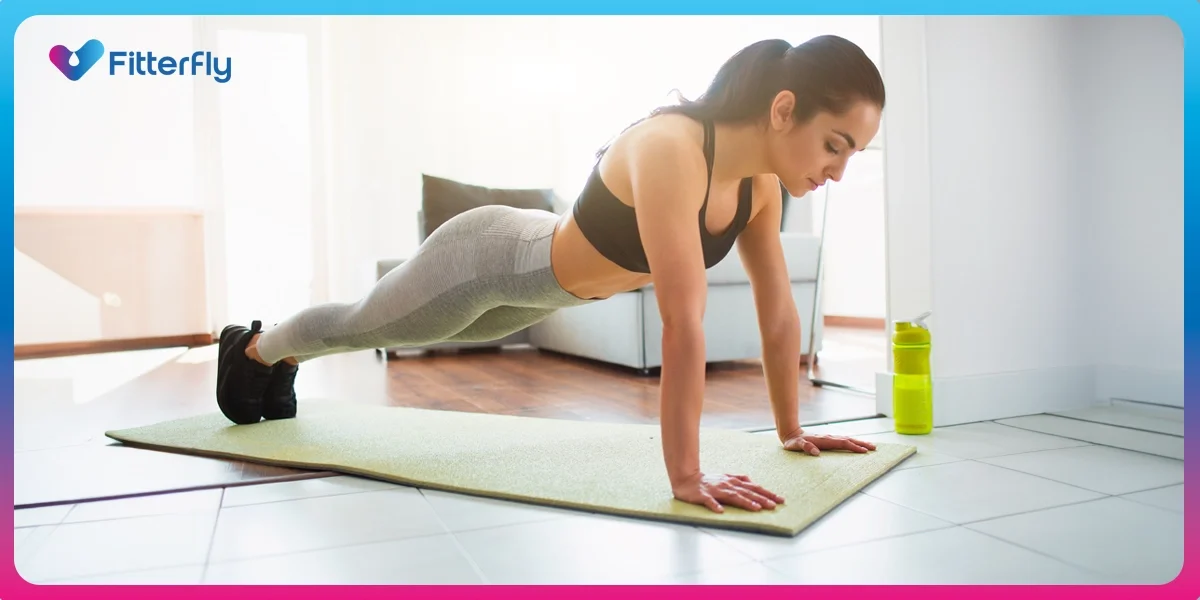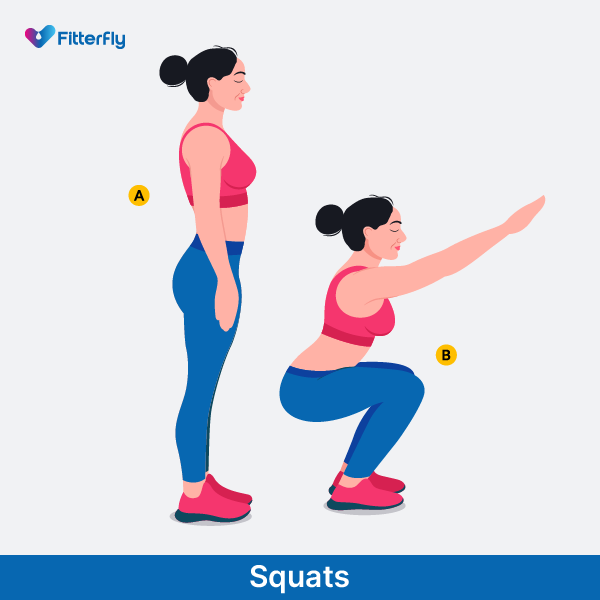5 Easy-to-do Best Exercise For Diabetes At Home

Exercising is essential for managing diabetes. Physical activity, or at least moving your body at short intervals, is very important when we talk about type 2 diabetes treatment or management.
One of the most glaring contributing factors towards India’s super-rapid rise as a diabetic nation is the sedentary lifestyle of our young population. This guide provides practical, safe, and effective home exercise for diabetes routines tailored for individuals with diabetes.
Exercising is not about Expensive Gymming
It goes without saying that keeping your body fit is a good step towards fighting complications of diabetes.
Exercising need not be an expensive, tedious, boring, or mentally exhausting chore that makes you run away in the opposite direction. Physical fitness can be made into fun workouts without wasting money on gym memberships.
Exercising is About Feeling Good while Sweating
Exercise keeps your muscles and bones healthy and releases neurotransmitters called endorphins that make you feel good. Once you feel happy in your mind and body, life fills with hope and spirit.
So, isn’t that a win-win situation for your body, mind, and spirit?
Regular exercise is crucial for managing diabetes. It helps control blood sugar levels, improve insulin sensitivity, and enhance overall health. This blog aims to provide you with easy-to-follow home exercise for diabetes routines to help you stay active and healthy.
Safety Considerations for Starting Home Exercise for Diabetes
Before starting any new home exercise for diabetes, it’s essential to keep a few safety tips in mind:
- Consult Your Doctor: Always consult your healthcare provider before beginning a new exercise regimen.
- Monitor Blood Sugar Levels: Check your blood sugar levels before and after exercising to ensure they stay within a safe range.
- Stay Hydrated: Drink plenty of water before, during, and after your workout.
- Have a Snack Ready: Keep a quick snack on hand in case of hypoglycemia (low blood sugar).
5 Simple Home Exercises for Diabetes Management
1. Jumping Jacks

Starting in a standing position, leap to spread your legs shoulder-width apart while simultaneously raising your arms above your head, then quickly jump back to the starting stance.
Perform this in 3 sets of 30 seconds to 1 minute each. Jumping jacks can burn approximately 8-14 calories per minute.
It is an excellent cardiovascular exercise that engages multiple muscle groups for a full-body warm-up or high-intensity interval training (HIIT) component.
2. Push-Ups


From a plank position, lower your body toward the floor by bending your elbows and push back up. Aim for sets of 10-15 push-ups, gradually increasing the number as you grow stronger.
Push-ups can burn around 7-10 calories per minute, focusing on strengthening the chest, shoulders, triceps, and engaging the core, thereby providing a compact upper body workout.
3. Squats


Stand with feet hip-width apart, then lower your body back as if sitting in a chair, keeping your chest upright. Rise back up to standing. Do 3 sets of 15-20 repetitions.
Squats can help you burn about 7-10 calories per minute, effectively targeting the lower body, including quadriceps, hamstrings, glutes, and calves, enhancing strength, balance, and flexibility.
4. Planks


Prop yourself on your elbows and toes, keeping a straight line from head to heels. Hold this position for 20-60 seconds for 2-3 sets.
Planking burns approximately 2-5 calories per minute, depending on intensity and individual factors. It’s a superb exercise for the core, strengthening the abdominal muscles, lower back, and shoulders and improving overall stability.
5. Burpees


Begin standing, squat down, place your hands on the ground, kick your feet back into a push-up position, do a push-up, return to squat, and jump up with arms overhead. Perform 2-3 sets of 10-15 burpees.
Burpees can burn around 10-15 calories per minute, offering a rigorous full-body workout that improves muscle strength, endurance, and cardiovascular fitness, making them exceptionally efficient for weight loss and conditioning.
Important Note: If you experience any pain or discomfort while exercising, please stop and check with your doctor or physiotherapist first.
Weekly Home Exercise Plan for Diabetes
Here’s a simple weekly exercise planner that you can follow. But like we said earlier, it’s best to check this with your fitness expert or a physiotherapist to see if it’s best for you.
| Day | Focus | Activities & Sets |
| Day 1 | Full Body & Cardio | – Warm-Up: Jumping Jacks (5 min) – 3×15 Push-Ups – 3×20 Squats – Burpees (2 min, as many as possible) – Cool Down: Stretching/Yoga (10 min) |
| Day 2 | Upper Body Strength & Core | – Warm-Up: Arm Circles, Wall Push-Ups (5 min) – 3×12 Push-Ups – 3×1-minute Planks – 3×15 Chair Dips, 3×15 biceps curls – Cool Down: Stretching for Arms/Abs (10 min) |
| Day 3 | Active Recovery | – 30-min Walk or Low-Impact Yoga Session |
| Day 4 | Lower Body Strength & Stability | – Warm-Up: High Knees (5 min) – 4×20 Squats – 3×15 Lunges per Leg – 2×20 Calf Raises – Cool Down: Lower Body Stretching (10 min) |
| Day 5 | Cardio & Core | – Warm-Up: Jumping Jacks (5 min) – 20 min HIIT (1 min high-intensity, 1 min rest/light activity – Minute on Minute cycles of push up, squats, burpees, mountain climber, reverse lunge) – 3×1-minute Planks – 3×15 Russian Twists – Cool Down: Full-Body Stretching (10 min) |
| Day 6 | Full Body Strength | – Warm-Up: Dynamic Stretching (5 min) – 3×10 Push-Ups – 3×20 Squats – 3×1-minute Planks – 3×15 Glute Bridges – Cool Down: Stretching for Worked Muscles (10 min) |
| Day 7 | Rest or Light Activity | – Complete Rest or Light Activity (e.g., Walking, Gentle Stretching, Leisurely Bike Ride) |
Tips for Staying Motivated
Staying motivated is key to maintaining a regular home exercise for diabetes routine. Here are some tips:
- Set Realistic Goals: Start with achievable exercise goals and gradually increase intensity.
- Track Progress: Keep a workout journal or use fitness apps to monitor your progress.
- Mix It Up: Vary your exercises to keep workouts interesting and target different muscle groups.
- Stay Connected: Join online fitness communities or virtual exercise classes for support and motivation.
How Can Fitterfly Help You?
At Fitterfly, we’ve got your back on your fitness journey. Our expert team first understands your current habits and lifestyle to pick exercises that feel right for you, especially if home workouts are your thing.
With us, you get personalized fitness plans and over 170 live sessions to guide you. Plus, we look deeper to find any pain that might be slowing you down.
REVERSED Diabetes in 3 months


5.7%
Happy members
EMI
Guarantee
4.8/5
Diabetes Prime Program
If you are dealing with diabetes or trying to shed some weight, give us a missed call at 08069450746, and let’s chat about getting you fitter in a way that works for you.
This blog provides general information for educational and informational purposes only and shouldn't be seen as professional advice.
Frequently Asked Questions
What is the best exercise for diabetes at home?
The best exercise for diabetes at home focuses on a mix of aerobic activities, strength training, and flexibility exercises. Aerobic exercises such as walking, cycling on a stationary bike, or swimming can help improve cardiovascular health and manage blood sugar levels. Strength training, using resistance bands or body-weight exercises like squats and lunges, can increase muscle mass, aiding in glucose metabolism. Flexibility exercises and yoga can enhance blood flow and reduce stress. Always consult with your fitness expert or physiotherapist before starting a new exercise regimen.
How can I effectively perform home exercises for diabetes management?
To effectively manage diabetes with home exercise for diabetes, start by: 1. Setting realistic goals and creating a routine, 2. To cover all aspects of fitness, incorporate various exercises, including aerobic, strength training, and flexibility exercises. 3. Monitor your blood sugar levels before and after exercise to understand how different activities affect you. 4. Stay hydrated, wear comfortable clothing, and ensure you have a safe space to exercise. 5. Regularity is key, so aim for at least 150 minutes of moderate-intensity activity per week, as recommended by health professionals.
Are there specific diabetes exercises I can do at home?
es, there are specific exercises that are beneficial for individuals with diabetes and can be quickly done at home. These include: Aerobic Exercises: Walking in place, dancing, and using a stationary bike. Strength Training: Using resistance bands or doing body-weight exercises such as push-ups, sit-ups, and chair squats. Flexibility and Balance: Practicing yoga or Pilates and doing stretches or balance exercises like standing on one foot.
What constitutes a good diabetes workout at home?
A good diabetes workout at home should include exercises that help control blood sugar, improve cardiovascular health, and increase strength and flexibility. Start with a 5-10 minute warm-up, followed by 20-30 minutes of aerobic exercise, such as brisk walking or cycling. Incorporate strength training two to three times a week, focusing on major muscle groups. Prefer doing multi-joint or full-body exercises which also resemble functional movements, such as squats, rowing, lunges etc. Conclude with a cool-down and stretching to prevent injury and improve flexibility. Monitoring your blood sugar levels before and after workouts is crucial to ensure safety and effectiveness.




















